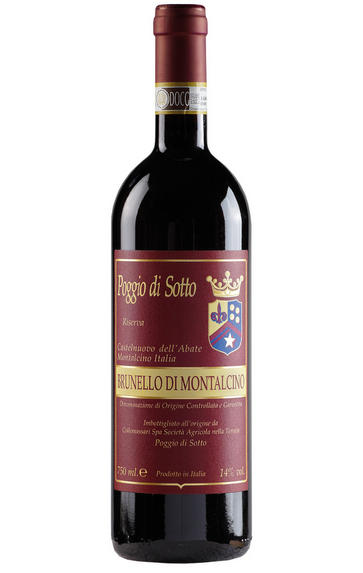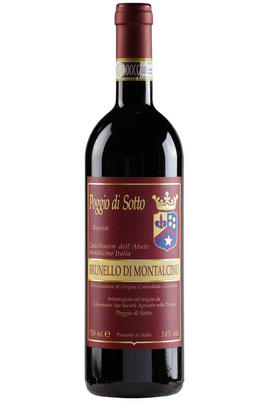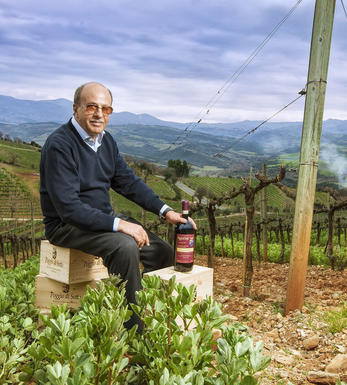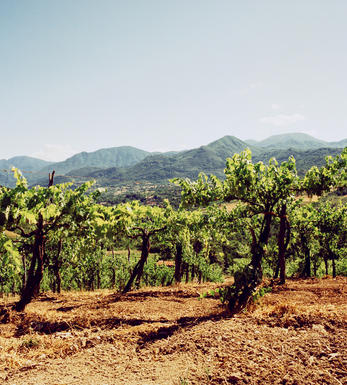
2018 Brunello di Montalcino, Riserva, Poggio di Sotto, Tuscany, Italy

Critics reviews
The 2018 Brunello di Montalcino Riserva is youthfully restrained, wafting up with a flowery blend of sweet herbs, crushed rocks and wild strawberries. It's soft-textured and round with a pretty inner sweetness up front and mineral-laden, wild berry fruits all propelled by juicy acidity. A core of grippy tannins lingers through the perfumed yet nuanced finale as traces of violet pastille taper off. The 2018 Riserva of Poggio di Sotto was matured in barrels the same as the Normale, just held back for an extra year. Moreover, the Riserva hails from a single vineyard primarily made up of marl-stone planted in 2001.
Drink 2025 - 2035
Eric Guido, Vinous (November 2023)
The Poggio di Sotto 2018 Brunello di Montalcino Riserva was reticent when I tasted it, probably owing to a period of awkwardness for such a young sample. The immediate suggestion is to give this bottle more time because, tasted now, it was definitely poured before its prime. The bouquet starts off with austere aromas of oil painting or waxed antiques, but those blow off. After that, you get an exciting compilation of redcurrant, cherry skin, rose petal and floral potpourri. This wine is very sprightly on the palate with fresh berry crush, integrated acidity and fine, chalky tannins. Again, this wine needs more time in bottle.
This is a set of impeccable wines. It must be said, however, that they started off very closed, and it took me a long while, with multiple tastings, to coax out the adjectives and descriptors you read here. I encountered the same thing with the wines of San Giorgio, which is under the same ownership. With this in mind, I definitely recommend more bottle age for Poggio di Sotto's new releases. It would be a shame to open these wines without giving them five more years at a minimum.
Drink 2030 - 2055
Monica Larner, Wine Advocate (December 2023)
Lustrous mid ruby with bright orange tinges. Complex, savoury and bursting with minerally, salty notes on the nose while still a little locked on the fruit. Fluid, polished sweet raspberry and cherry fruit and sweet-tasting tannins. Long and elegant and yet packed with fruit.
Drink 2026 - 2040
Walter Speller, JancisRobinson.com (October 2023)
Selected from a single 30 hectolitre cask, Poggio di Sotto’s Riserva usually remains in wood for a full 45 months. In 2018, however, time in barrel was reduced to just 30 to retain the vintage’s freshness and elegance, and this truly comes through in the wine. With coaxing, it emerges from its reductive cocoon to reveal nuances of chestnut and flinty river stone, before blossoming with thyme and lavender. Graceful and streamlined, the mid-weight palate rings out with red cherry, orange peel and an intrinsic juiciness. The tannins are silky and seamless, and there's an appetising crunch of forest berries which lingers on the finish. Delicious now with a proper decant, but will continue to charm for at least a decade.
Drink 2024 - 2034
Michaela Morris, Decanter (November 2023)
The nose of the 2018 Brunello Di Montalcino Riserva is pure and inviting, with aromas of red cherry liqueur, rose petals, candied orange peel, fresh rosemary, and wet stones. Long and pure on the palate, it offers beautifully concentrated ripeness, with a weightless feel and a seamless structure with ripe tannins. Everything about it resonates on the palate, and it’s harmonious all the way through. It’s singing now and will have an open drinking window over the next 15-20 years.
Drink 2024 - 2044
Audrey Frick, JebDunnuck.com (February 2024)
About this WINE

Poggio di Sotto
Poggio di Sotto was founded in 1989 by Piero Palmucci, rapidly becoming known for benchmark, classical Brunello. Since 2011, it has been managed by the ColleMassari group and chief enologo, Luca Marrone. The wines are radical in style, challenging in youth but built to cellar. The estate is on the south-east extremities of the region. The vineyards perch above the Orcia river, in the shadow of Mount Amiata. The extinct volcano is often snowcapped, even in summer. Its cold winds soften the summer heat, bringing finesse to these wines.
The estate is split into three vineyards. The soils vary: the vines soak up mineral details from the rocky marl; marine-fossil-filled galestro; and the prized vineyards towards the top of the hill, which hold iron-rich clay.

Brunello di Montalcino
Along with Chianti, Brunello di Montalcino is Tuscany's most famous DOCG and the region's boldest expression of Sangiovese. Located 30 miles south of Siena with the hilltop town of Montalcino as its epicentre, its 2,000 hectares of vines are naturally delimited by the Orcia, Asso and Ombrone valleys. Brunello is the local name for the Sangiovese Grosso clone from which Brunello di Montalcino should be made in purezza (ie 100 percent).
The Brunello di Montalcino DOCG has a whale-like shape: at its head, at 661 metres above sea level on ancient, stony galestro soils facing east and southeast lies the town of Montalcino, where the DOC was founded. As you follow the spine south towards the tail, the vineyards lose altitude – those around Colle Sant'Angelo are at 250 metres – while the soils become richer with iron and clay. Further east, in the shadow of the 1,734 metre Mont'Amiata lies the village of Castelnuovo dell'Abate where the vineyards are strewn with a rich mix of galestro, granitic, volcanic, clay and schist soil types.
Historically, the zone is one of Tuscany's youngest. First praised in 1550 by Leandro Alberti for the quality of its wines, it was Tenuta Il Greppo who bottled the inaugural Brunello di Montalcino in 1888. By 1929, the region had 925 hectares of vines and 1,243 hectares of mixed crops, while in 1932 it was decreed that only those wines made and bottled within the commune could be labelled as Brunello di Montalcino. Since then, the number of producers has risen from 11 in 1960 to 230 in 2006, while over the same period the vineyards have expanded from 1,000 hectares to 12,000. The region earned its DOC in 1966, and was upgraded to DOCG in 1980.
Brunello di Montalcino cannot be released for sale until five years after the harvest, or six years in the case of Brunello di Montalcino Riserva. During this time the wines should be aged for at least two years in oak, followed by at least four months in bottle (six months for Riservas); maximum yields are 55 hl/ha.
Rosso di Montalcino is declassified Brunello di Montalcino, released for sale 18 months after the harvest.
Recommended producers: Costanti, Fuligni, Lisini, San Giuseppe, Soldera, Cerbaiona

Sangiovese
A black grape widely grown in Central Italy and the main component of Chianti and Vino Nobile di Montepulciano as well as being the sole permitted grape for the famed Brunello di Montalcino.
It is a high yielding, late ripening grape that performs best on well-drained calcareous soils on south-facing hillsides. For years it was blighted by poor clonal selection and massive overcropping - however since the 1980s the quality of Sangiovese-based wines has rocketed upwards and they are now some of the most sought after in the world.
It produces wines with pronounced tannins and acidity, though not always with great depth of colour, and its character can vary from farmyard/leather nuances through to essence of red cherries and plums. In the 1960s the advent of Super Tuscans saw bottlings of 100% Sangiovese wines, as well as the introduction of Sangiovese/Cabernet Sauvignon blends, the most famous being Tignanello.


Buying options
Add to wishlist
Description
Luca describes the 2018 harvest as an “old classic” due to the growing conditions of the year. A vintage with a cooler summer and ample rain gave freshness and elegance, which fits the philosophy of this famous Fattoria. The Riserva is made from the estate’s oldest vineyards. Wines undergo natural fermentation in traditional large Slovenian oak, followed by a shorter-than-usual 30 months in botti and four in concrete, before bottling in November 2021. This Riserva is cool and sophisticated, filled with mineral essence and pure elegance. This may be the best wine of the vintage.
Drink 2026 - 2040
Berry Bros. & Rudd
wine at a glance
Delivery and quality guarantee